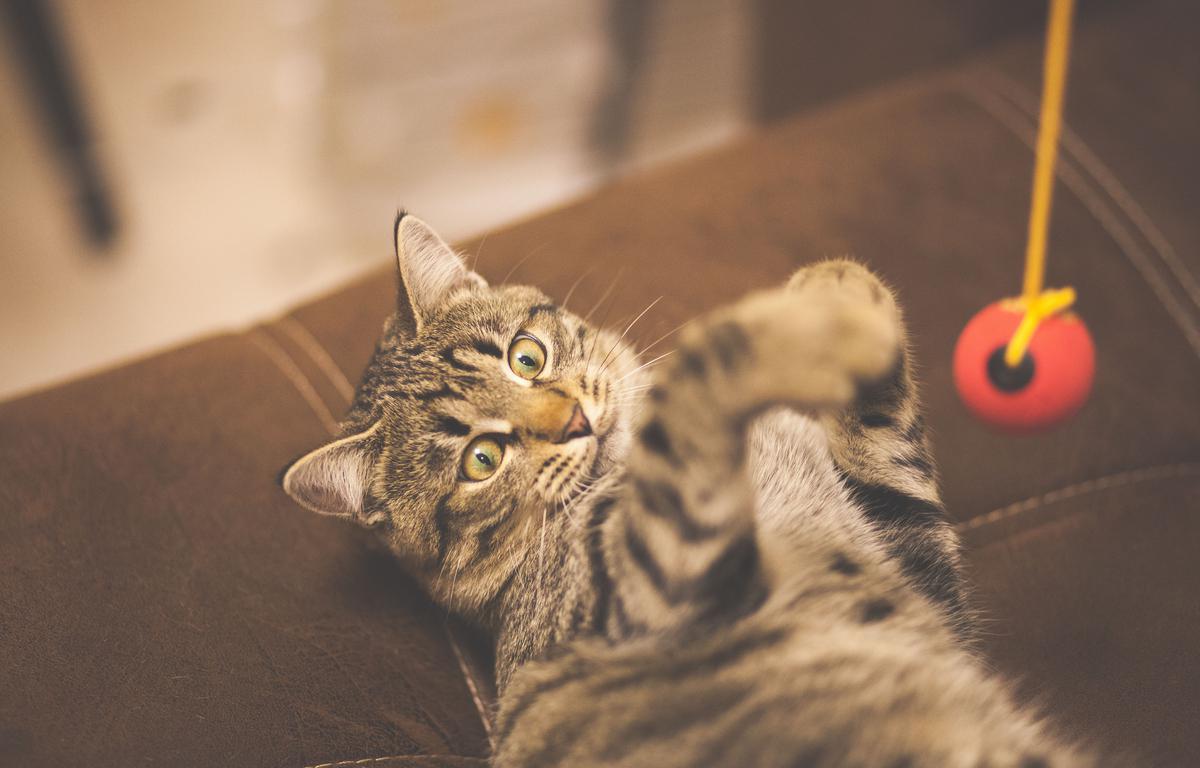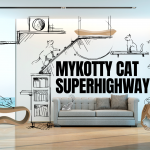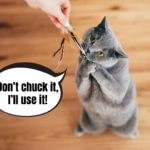Cats are born hunters and love to play catching, lurking, jumping, scratching or kicking – they know plenty of ways to have fun! You know – they are perfectionists in every profession:) Pets need our attention and time to play – no doubt about it. But that doesn’t mean that cats can’t have toys to play with, they’re very creative beasts after all. The popularity of the zero waste trend, which is motivated by reducing the amount of waste going into the environment, encourages us to look for better, less harmful and safe toys for nature and our pets. Cat keepers can consciously reduce waste by making their own ECO cat toys. Anyway, for us it can also be quite fun and a reason to reveal our more or less hidden, manual talents:)
Why do cats need toys?
Purrings are very clever animals that need constant brain stimulation as they quickly become bored. How active a cat is depends mainly on its character. But in nature, the primary activity of a cat is hunting. Domesticated cats are deprived of daily struggle or food, but their hunting instinct often pushes them into unexpected behaviour. Any attempt to subdue the cat’s nature can result in frustration and behavioural disorders. Lack of exercise is also the most common cause of overweight in cats. It’s therefore worth providing entertainment for housewives by giving ECO cat toys that will be a substitute for hunting.
How do I choose my cat’s toys?
Lying in nature, cat hunting requires agility and speed, as well as the ability to observe. Interactive cat toys are effective in developing and stimulating the instinct. It’s therefore worth looking for toys that will become your cat’s hunting game. Cats prefer different hunting styles. Some of them are chasing their prey, others are preparing themselves for the game by lurking out of hiding, and there are some that love to train the latter on our human ankles 🙂 Nevertheless, the most important issue is the possibility of exploring your territory and hunting a given object by catching, often biting or digging it. That’s why it’s good to choose toys that stimulate our cat and don’t bore him or even discourage him from playing. A well matched toy for cat character will give a lot of fun for both cats and us, because there’s nothing better than to look at a furry cat raging around the house:)
Although cats walk their own paths and really like to experience a bit of peace and solitude, they enjoy interacting with humans most. Therefore, apart from all interactive toys for cats, there shouldn’t be any ordinary rod with a piece of cloth, string or feathers in the house, whose movement will be driven by the Carer. Everything that is an extension of the human hand will be attractive for the cat, because the most important thing is that we play together with him, we give him our commitment and emotions connected with it – the cat feels and reacts adequately to our activity. That’s why mechanical waving the rod while browsing Facebook will not encourage the cat to play together… The cool thing about it all is that creativity in playing with a cat knows no boundaries.
Zero Waste Cat Toys
The vast majority of cats are accustomed to playing with objects that are in their sight, most often these are all kinds of ribbons, lost potato peelings, crumpled paper or strings from our tracksuits (by the way, currently all our home tracksuits have bitten strings – cats simply love them:) Interesting for cats are also toys with catnip or valerian (or preferably both at the same time, like our KungFu Cat Toy) and those with laser pointer or toys with feathers. Some furs react very well to those that make some noises while playing, such as banging or ringing. For example, our red-headed Figo loved a piece of wire rolled into a ball, which while throwing it on the floor, he mercilessly searched for, stimulating Figo to even greater momentum behind this metal “animal”. But our beloved Luis, the protophile of myKotty, was even crazy about all kinds of paper, be it in the form of a newspaper spread out on the sofa that rustled voices beneath it into the sky or in the form of a rolled-up ball that he chased around the house.
Cats don’t need mega expensive toys to stimulate their nature. It all depends on their preferences but also on how we encourage them to play. It’s a good idea to use things in the house, such as ribbons, strings and thongs, with which we can make the aforementioned rods by attaching them to a stick. Another solution maintained in the spirit of zero waste is a rolled up newspaper ball or cardboard box after a scratching post, cardboard house or any other product in which you can cut a few holes and put something to play with, for example a ball inside. Toys made with the DIY (Do It Yourself) method can be made from a bottle cap, material cuttings, paper towel rolls or a large cardboard box left after buying electronic equipment or after our large beds (like OTI or EMI). An example of ECO toys for cats can be:
● a cat mouse – made with a polystyrene mould or an egg-shaped plastic shell. To enhance the effect, you can use natural feathers and glue them with hot-melt glue or simply stick them in the polystyrene foam. At the end, all you have to do is draw your eyes and moustache using a marker – a claw on a brick brave!:)
● Pizza boxes – they have great potential especially when carbohydrate eaters and cats live under one roof. We ate a pizza and we wonder what to do with the pizza box? Nothing more simple – let’s make holes in it… and put your favourite treats or rolling ball toys inside the box – the cat will be delighted! We did such a miracle with our myCat box from cardboard cat house MIA – cats went crazy:) See for yourself:
● a cat rod – it can be made with literally several elements. We will need: a wooden stick, a string, a thong, natural feathers or material cuttings, which we join with hot glue or string to one of the ends of the stick.
Toilet paper roll – we know that in the times of the current pandemic it can be a luxury commodity, but it is worth reaching for it as it can be used to make a simple ball or a funny roll with jagged ends. To make it we only need scissors, with which we cut the roll into two equal parts, and each of them is cut to fray its ends and slightly bend outside.
The last toy is an extended version of a pizza box. It works especially when we have more than one cat at home and at least one of them loves to hide in the boxes (and is there a cat in the universe who doesn’t like it…?:) We need a cardboard box with strong walls and a size enough to fit a cat. We used the box after our VIGO scratcher for this. Shoe boxes will also work out, especially boots or glans, because others may be too small. We cut out holes in all walls. Almost certainly one of our cats will be interested in the box and will enter it (you know this rule, which undoubtedly works for cats: “If it fits…I sits”:) The other one wants to use it to attack a helpless friend in this situation, and thick walls of the box will help in an effective attack from above. Fun in “cat and mouse” is guaranteed. Any ointment of cords, thongs, paper scraps attached to the cardboard will surely be an additional attraction for your furry guy.
These simplest toys are very economical and will last for a long time, and even if they wear out faster than we expected, we won’t be so sorry and we can always build a second, improved version of them. The limitation to preparing such toys is only our imagination, and who, if not us, Kittens, has more than enough imagination!
Most of the presented toys have their equivalents in mass production, but often their price effectively deters potential buyers. For people living in the spirit of zero waste or those who simply pay attention to environmental issues, buying toys made of artificial materials may be too harmful to our Mother Earth. Toys made at home can be cheaper and more ecological, but not all of them can be accurately reproduced in relation to those available on sale. However, toys can be more durable and contain materials that we don’t have at home, such as cat herbs, catnip or valerian. So consider all the pros and cons of choosing a toy that you buy in the shop and a toy that you made yourself. Remember one thing – it’s the cat at the very end that will decide what’s MIAL and what’s not!
Do you have manual skills and make toys for your pets yourself? Be sure to boast about your work in your comments! We are looking for inspiration…




